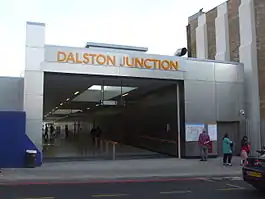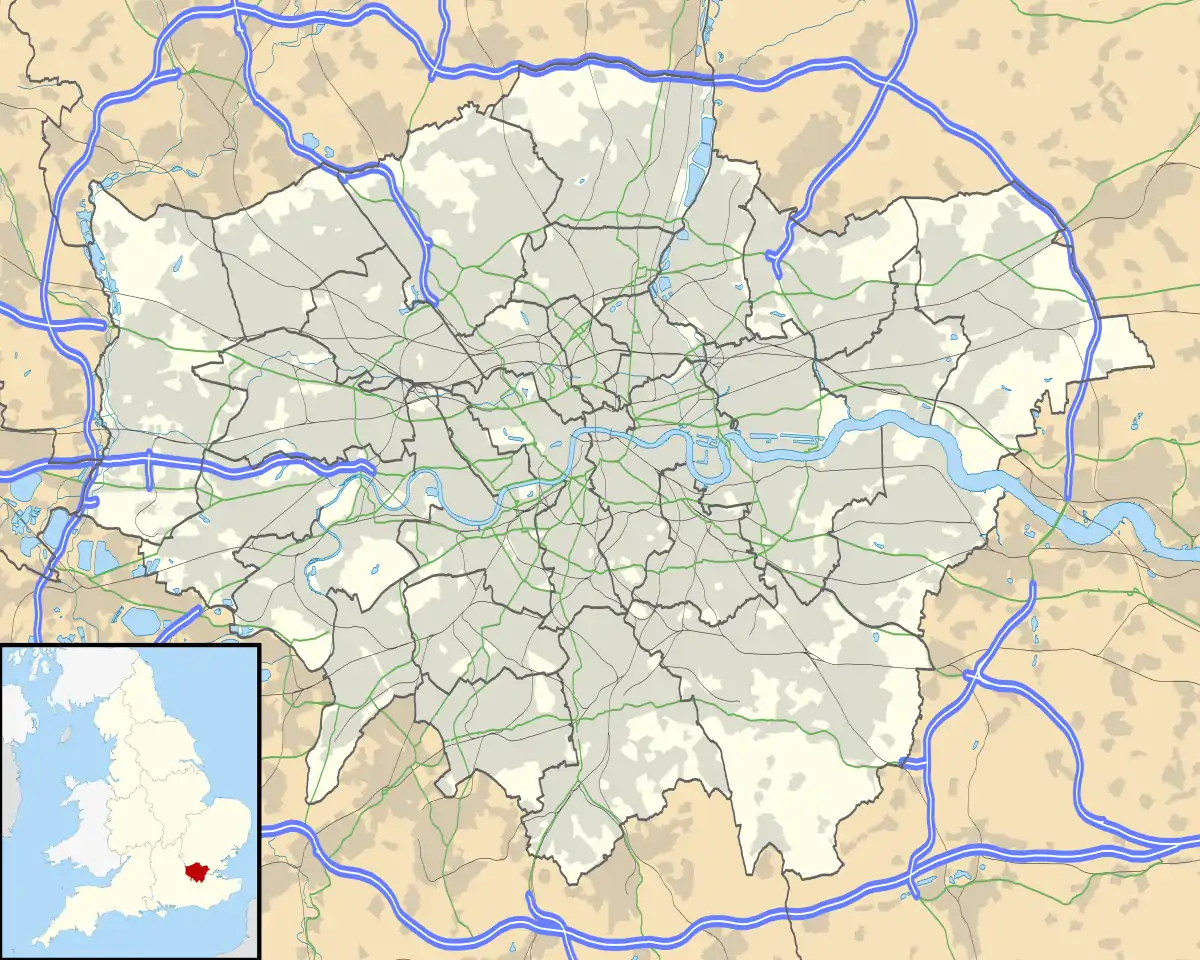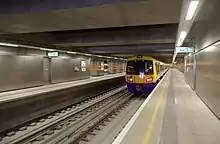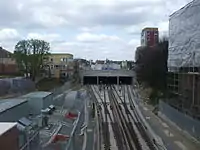Dalston Junction railway station
Dalston Junction (pronounced /ˈdɔːlstən/) is an inter-modal rail and bus transport interchange in Dalston, London. It is located at the crossroads of Dalston Lane, Kingsland Road and Balls Pond Road. The station served by London Overground East London line and is in Zone 2.[4] The station is located in a short section of cut and cover tunnel north of the Kingsland Viaduct.
| Dalston Junction | |
|---|---|
 North entrance on day of re-opening in April 2010 | |
 Dalston Junction Location of Dalston Junction in Greater London | |
| Location | Dalston |
| Local authority | London Borough of Hackney |
| Managed by | London Overground |
| Owner | Transport for London |
| Station code | DLJ |
| Number of platforms | 4 |
| Accessible | Yes[1] |
| Fare zone | 2 |
| OSI | Dalston Kingsland |
| National Rail annual entry and exit | |
| 2015–16 | |
| 2016–17 | |
| 2017–18 | |
| 2018–19 | |
| – interchange | 15[3] |
| 2019–20 | |
| Railway companies | |
| Original company | North London Railway |
| Pre-grouping | London and North Western Railway |
| Post-grouping | LMS |
| Key dates | |
| 1 November 1865 | Opened |
| 30 June 1986 | Closed |
| 27 April 2010 | Reopened (as temporary ELL terminus) |
| 28 February 2011 | Fully reopened with through service to Highbury and Islington |
| Other information | |
| External links | |
| WGS84 | 51.54539°N 0.07474°W |
History
Original station
The station was first opened on 1 November 1865 by the North London Railway on its "City Extension" from the North London line to Broad Street in the City of London. It had three island platforms with four through lines joining the west side of the North London line, and two joining the east. The station had no overall roof.
The line to Broad Street and the station closed after the last trains ran on 27 June 1986.[5] However, the location at the corner of Kingsland High Street and Dalston Lane retained the name Dalston Junction on road and bus signs throughout the period that the station was closed.
Re-opened station

Rebuilding the station for the London Overground network began with site clearance in early 2005. The station was opened by the Mayor of London, Boris Johnson, on 27 April 2010. A limited weekday "preview" service started that day with the first train leaving Dalston Junction at 12.05. The service was of eight trains per hour between Dalston Junction and Surrey Quays station from 07:00 to 20:00; four of the eight trains continued to New Cross Gate and four to New Cross.[6]
The full service to West Croydon with branches to New Cross and Crystal Palace began on 23 May 2010, at hours similar to those of the London Underground.[7] The service interval to each of the three southern terminals is approximately fifteen minutes for most of the day, though greater early mornings, late evenings, and parts of Sundays. The South London line was open to the public on 9 December 2012 and officially launched the next day by the Mayor, with the station now serving as the northern terminus to New Cross and West Croydon trains. Clapham Junction (via Surrey Quays) and Crystal Palace trains now start from Highbury & Islington.[8] In the first phase of the extension of the East London Line, Dalston Junction was the temporary northern terminus for all trains. From 28 February 2011 to 9 December 2012, trains from West Croydon and Crystal Palace continued beyond Dalston Junction, taking the relaid west curve north of the station to Highbury & Islington. As stated above, Dalston Junction still remains a terminal for New Cross trains, using the two bay platforms in the middle of the station.[9] Transport for London and Hackney London Borough Council are currently developing the extensive station site with a bus interchange and high-rise towers above the new station.[10] On 6 December 2012, The Co-operative Food opened a branch, located left of the station's main entrance.[11]
The new station has two platform islands, the outer sides of each providing through services, the inner bay faces supporting terminating services. Although the route eastward at the north end of the station has been protected it would require substantial reconstruction first. The entire station is underneath a new building development.
Station layout

The western of the two chords north of the station was reinstated on 28 February 2011 for East London Line services to Highbury & Islington. There are no plans to rebuild the eastern chord but its alignment has been safeguarded.[12] The eastern chord was used by Broad Street services to Poplar until 1944 and freight services until 1965.[13] The City Extension to the south was mainly four-track but now has only two. The wide site at Dalston Junction has in the past had six platforms.
Services
London Overground
Rail services are provided by London Overground. As of 9 December 2012 Mondays to Saturdays there is a service every 5–10 minutes throughout the day, while on Sundays before 13:00 there is a service every 5–9 minutes, changing to every 7–8 minutes until the end of service after that.[14] Current off peak frequency is:[9]
- 4 tph Southbound to West Croydon
- 4 tph Southbound to Crystal Palace
- 4 tph Southbound to New Cross
- 4 tph Southbound to Clapham Junction
- 8 tph Northbound to Highbury & Islington
- 8 tph terminate here from Clapham Junction or New Cross
Lines
| Preceding station | Following station | |||
|---|---|---|---|---|
towards Highbury & Islington | East London Line | |||
| Terminus | ||||
| Disused Railways | ||||
| Mildmay Park | North London Railway Broad Street-Richmond |
Broad Street | ||
| Hackney Central | North London Railway Broad Street-Poplar |
Haggerston | ||
| Canonbury | British Rail Eastern Region North London Line (City Branch) |
Broad Street | ||
Future
A new Dalston station has been proposed on the Crossrail 2 route between Surrey and North London and Hertfordshire should it be built.
References
- "Step free Tube Guide" (PDF). Transport for London. May 2020. Archived (PDF) from the original on 7 August 2020.
- "Out-of-Station Interchanges" (Microsoft Excel). Transport for London. 2 January 2016. Retrieved 28 August 2016.
- "Station usage estimates". Rail statistics. Office of Rail Regulation. Please note: Some methodology may vary year on year.
- http://www.tfl.gov.uk/assets/downloads/standard-tube-map.pdf
- "List of dates from 1 January 1985 to 20 January 2006 of last passenger trains at closed BR (or Network Rail stations since privatisation)". Department for Transport Website: Freedom of Information Act responses, February 2006. Department for Transport. 2006. Archived from the original on 21 August 2008. Retrieved 14 February 2014.
- "East London Line officially opened by Boris Johnson". BBC News. 27 April 2010. Retrieved 29 June 2010.
- "East London Line reopening dubbed 'political stunt'". BBC News. 14 April 2010. Retrieved 29 June 2010.
- "Archived copy" (PDF). Archived from the original (PDF) on 7 April 2013. Retrieved 2013-02-25.CS1 maint: archived copy as title (link)
- "Timetable: Highbury & Islington - West Croydon" (PDF). Transport for London. Archived from the original (PDF) on 8 April 2011. Retrieved 28 February 2011.
- "East London Line Planning Brief". Archived from the original on 1 July 2009.
- "The Co-operative opens, Dalston Junction, December 6 2012". Flickr - Photo Sharing!.
- Catford, Nick (4 June 2015). "Disused Stations Site Report: Dalston Junction". Disused Stations: Closed Railway Stations in the UK. Retrieved 14 May 2016.
- Chronology of London Railways by H.V.Borley
- "Archived copy" (PDF). Archived from the original (PDF) on 8 April 2011. Retrieved 28 February 2011.CS1 maint: archived copy as title (link)
External links
| Wikimedia Commons has media related to Dalston Junction railway station. |